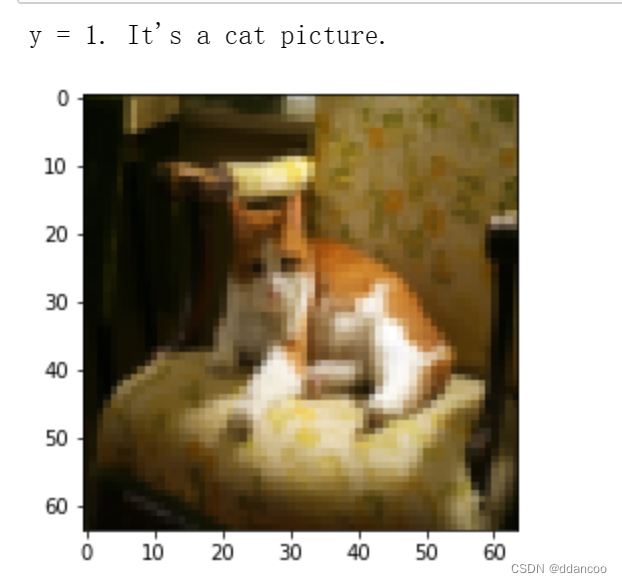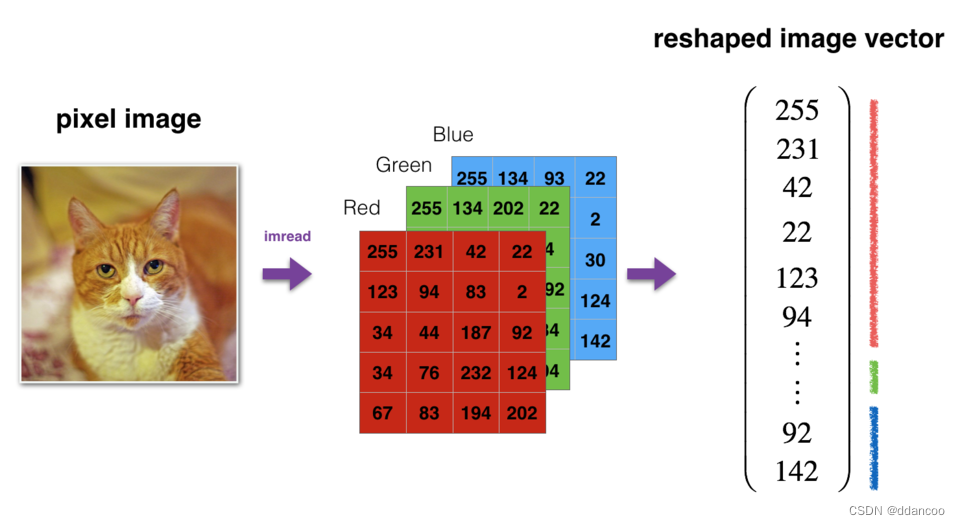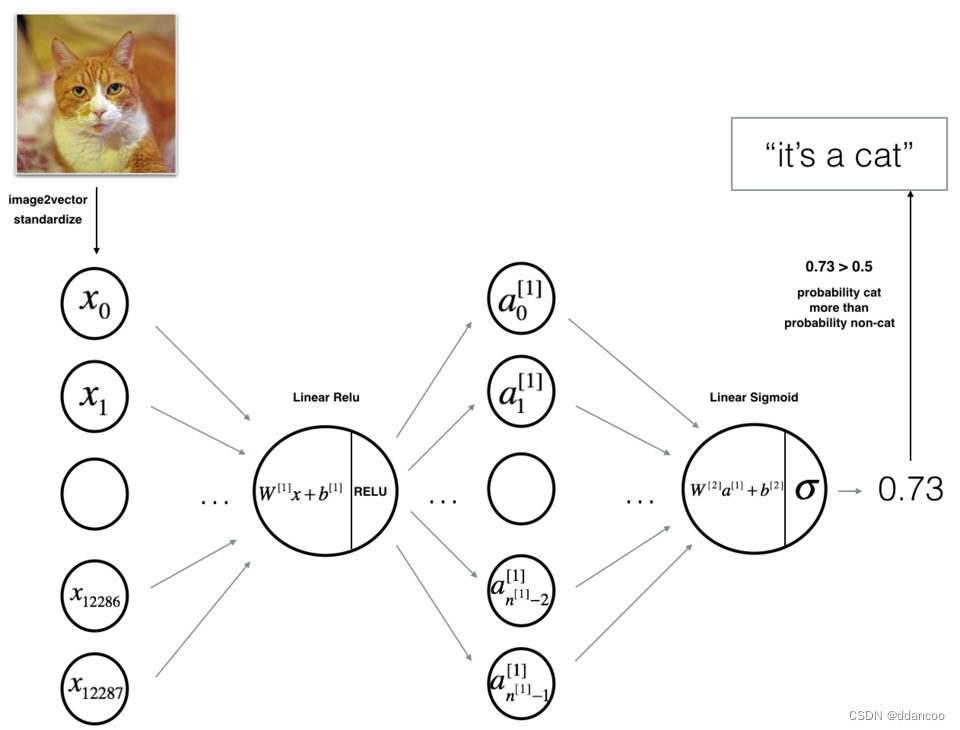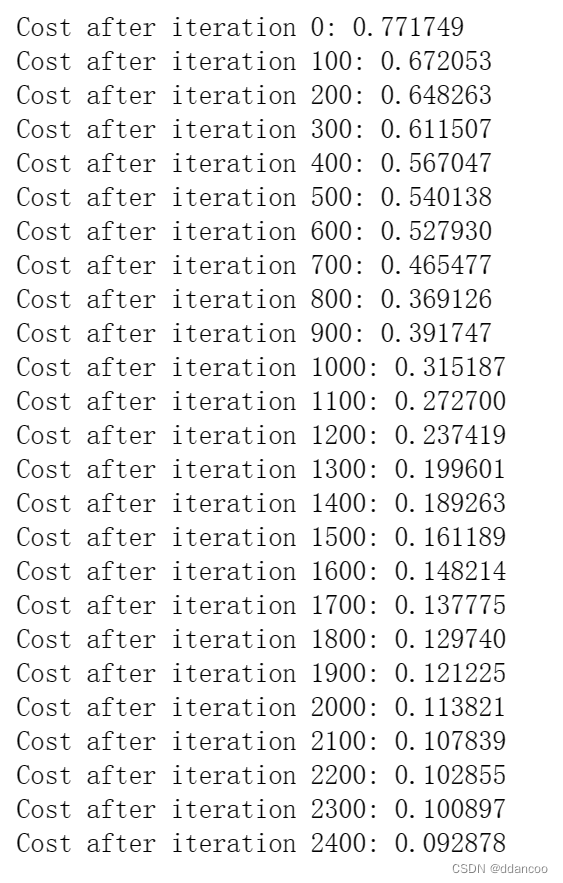吴恩达深度学习L1W4作业2
深度神经网络应用--图像分类
完成此作业后,你将完成第4周最后的编程任务,也是本课程最后的编程任务!
你将使用在上一个作业中实现的函数来构建深层网络,并将其应用于分类cat图像和非cat图像。 希望你会看到相对于先前的逻辑回归实现的分类,准确性有所提高。
完成此任务后,你将能够:
- 建立深度神经网络并将其应用于监督学习。
让我们开始吧!
1 安装包
让我们首先导入在作业过程中需要的所有软件包。
- numpy是Python科学计算的基本包。
- matplotlib?是在Python中常用的绘制图形的库。
- h5py是一个常用的包,可以处理存储为H5文件格式的数据集
- 这里最后通过PIL和?scipy用你自己的图片去测试模型效果。
- dnn_app_utils提供了上一作业教程“逐步构建你的深度神经网络”中实现的函数。
- np.random.seed(1)使所有随机函数调用保持一致。 这将有助于我们评估你的作业。
cd ../input/deeplearning46278 /home/kesci/input/deeplearning46278
import time
import numpy as np
import h5py
import matplotlib.pyplot as plt
import scipy
from PIL import Image
from scipy import ndimage
from dnn_app_utils_v2 import *
%matplotlib inline
plt.rcParams['figure.figsize'] = (5.0, 4.0) # set default size of plots
plt.rcParams['image.interpolation'] = 'nearest'
plt.rcParams['image.cmap'] = 'gray'
%load_ext autoreload
%autoreload 2
np.random.seed(1)2 数据集
你将使用与“用神经网络思想实现Logistic回归”(作业2)中相同的“cats vs non-cats”数据集。 此前你建立的模型在对猫和非猫图像进行分类时只有70%的准确率。 希望你的新模型会更好!
问题说明:你将获得一个包含以下内容的数据集("data.h5"):
???? - 标记为cat(1)和非cat(0)图像的训练集m_train
???? - 标记为cat或non-cat图像的测试集m_test
???? - 每个图像的维度都为(num_px,num_px,3),其中3表示3个通道(RGB)。
让我们熟悉一下数据集吧, 首先通过运行以下代码来加载数据。
train_x_orig, train_y, test_x_orig, test_y, classes = load_data()?运行以下代码以展示数据集中的图像。 通过更改索引,然后重新运行单元以查看其他图像。
# Example of a picture
index = 7
plt.imshow(train_x_orig[index])
print ("y = " + str(train_y[0,index]) + ". It's a " + classes[train_y[0,index]].decode("utf-8") + " picture.")?
# Explore your dataset
m_train = train_x_orig.shape[0]
num_px = train_x_orig.shape[1]
m_test = test_x_orig.shape[0]
print ("Number of training examples: " + str(m_train))
print ("Number of testing examples: " + str(m_test))
print ("Each image is of size: (" + str(num_px) + ", " + str(num_px) + ", 3)")
print ("train_x_orig shape: " + str(train_x_orig.shape))
print ("train_y shape: " + str(train_y.shape))
print ("test_x_orig shape: " + str(test_x_orig.shape))
print ("test_y shape: " + str(test_y.shape))?
与往常一样,在将图像输入到网络之前,需要对图像进行重塑和标准化。 下面单元格给出了相关代码。

# Reshape the training and test examples
train_x_flatten = train_x_orig.reshape(train_x_orig.shape[0], -1).T # The "-1" makes reshape flatten the remaining dimensions
test_x_flatten = test_x_orig.reshape(test_x_orig.shape[0], -1).T
# Standardize data to have feature values between 0 and 1.
train_x = train_x_flatten/255.
test_x = test_x_flatten/255.
print ("train_x's shape: " + str(train_x.shape))
print ("test_x's shape: " + str(test_x.shape))
?
?12,288等于64×64×364×64×3,这是图像重塑为向量的大小。
3 模型的结构
?
现在你已经熟悉了数据集,是时候建立一个深度神经网络来区分猫图像和非猫图像了。
你将建立两个不同的模型:
- 2层神经网络
- L层深度神经网络
然后,你将比较这些模型的性能,并尝试不同的L值。
让我们看一下两种架构。
3.1 2层神经网络

图2:2层神经网络。
该模型可以总结为:INPUT -> LINEAR -> RELU -> LINEAR -> SIGMOID -> OUTPUT
图2的详细架构:
- 输入维度为(64,64,3)的图像,将其展平为大小为(12288,1)的向量。
- 相应的向量:
 乘以大小为
乘以大小为 的权重矩阵
的权重矩阵。
- 然后添加一个偏差项并按照公式获得以下向量:
 。
。 - 然后,重复相同的过程。
- 将所得向量乘以
并加上截距(偏差)。
- 最后,采用结果的sigmoid值。 如果大于0.5,则将其分类为猫。
3.2 L层深度神经网络
用上面的方式很难表示一个L层的深度神经网络。 这是一个简化的网络表示形式:

图3:L层神经网络。
该模型可以总结为:[LINEAR -> RELU]?×?(L-1) -> LINEAR -> SIGMOID
图3的详细结构:
- 输入维度为(64,64,3)的图像,将其展平为大小为(12288,1)的向量。
- 相应的向量:
 乘以权重矩阵
乘以权重矩阵,然后加上截距
,结果为线性单位。
- 接下来计算获得的线性单元。对于每个(
),可以重复数次,具体取决于模型体系结构。
- 最后,采用最终线性单位的sigmoid值。如果大于0.5,则将其分类为猫。
3.3 通用步骤
与往常一样,你将遵循深度学习步骤来构建模型:
????1.初始化参数/定义超参数
????2.循环num_iterations次:
????????a. 正向传播
????????b. 计算损失函数
????????C. 反向传播
????????d. 更新参数(使用参数和反向传播的梯度)
????4.使用训练好的参数来预测标签
现在让我们实现这两个模型!
4 两层神经网络
问题:使用你在上一个作业中实现的辅助函数来构建具有以下结构的2层神经网络:LINEAR -> RELU -> LINEAR -> SIGMOID,你可能需要的函数及其输入为:
def initialize_parameters(n_x, n_h, n_y):
...
return parameters
def linear_activation_forward(A_prev, W, b, activation):
...
return A, cache
def compute_cost(AL, Y):
...
return cost
def linear_activation_backward(dA, cache, activation):
...
return dA_prev, dW, db
def update_parameters(parameters, grads, learning_rate):
...
return parameters### CONSTANTS DEFINING THE MODEL ####
n_x = 12288 # num_px * num_px * 3
n_h = 7
n_y = 1
layers_dims = (n_x, n_h, n_y)# GRADED FUNCTION: two_layer_model
def two_layer_model(X, Y, layers_dims, learning_rate = 0.0075, num_iterations = 3000, print_cost=False):
"""
Implements a two-layer neural network: LINEAR->RELU->LINEAR->SIGMOID.
Arguments:
X -- input data, of shape (n_x, number of examples)
Y -- true "label" vector (containing 0 if cat, 1 if non-cat), of shape (1, number of examples)
layers_dims -- dimensions of the layers (n_x, n_h, n_y)
num_iterations -- number of iterations of the optimization loop
learning_rate -- learning rate of the gradient descent update rule
print_cost -- If set to True, this will print the cost every 100 iterations
Returns:
parameters -- a dictionary containing W1, W2, b1, and b2
"""
np.random.seed(1)
grads = {}
costs = [] # to keep track of the cost
m = X.shape[1] # number of examples
(n_x, n_h, n_y) = layers_dims
# Initialize parameters dictionary, by calling one of the functions you'd previously implemented
### START CODE HERE ### (≈ 1 line of code)
parameters=initialize_parameters(n_x,n_h,n_y)
### END CODE HERE ###
# Get W1, b1, W2 and b2 from the dictionary parameters.
W1 = parameters["W1"]
b1 = parameters["b1"]
W2 = parameters["W2"]
b2 = parameters["b2"]
# Loop (gradient descent)
for i in range(0, num_iterations):
# Forward propagation: LINEAR -> RELU -> LINEAR -> SIGMOID. Inputs: "X, W1, b1". Output: "A1, cache1, A2, cache2".
### START CODE HERE ### (≈ 2 lines of code)
A1,cache1=linear_activation_forward(X,W1,b1,activation="relu")
A2,cache2=linear_activation_forward(A1,W2,b2,activation="sigmoid")
### END CODE HERE ###
# Compute cost
### START CODE HERE ### (≈ 1 line of code)
cost=compute_cost(A2,Y)
### END CODE HERE ###
# Initializing backward propagation
dA2 = - (np.divide(Y, A2) - np.divide(1 - Y, 1 - A2))
# Backward propagation. Inputs: "dA2, cache2, cache1". Outputs: "dA1, dW2, db2; also dA0 (not used), dW1, db1".
### START CODE HERE ### (≈ 2 lines of code)
dA1,dW2,db2=linear_activation_backward(dA2,cache2,activation="sigmoid")
dA0,dW1,db1=linear_activation_backward(dA1,cache1,activation="relu")
### END CODE HERE ###
# Set grads['dWl'] to dW1, grads['db1'] to db1, grads['dW2'] to dW2, grads['db2'] to db2
grads['dW1'] = dW1
grads['db1'] = db1
grads['dW2'] = dW2
grads['db2'] = db2
# Update parameters.
### START CODE HERE ### (approx. 1 line of code)
parameters=update_parameters(parameters,grads,learning_rate)
### END CODE HERE ###
# Retrieve W1, b1, W2, b2 from parameters
W1 = parameters["W1"]
b1 = parameters["b1"]
W2 = parameters["W2"]
b2 = parameters["b2"]
# Print the cost every 100 training example
if print_cost and i % 100 == 0:
print("Cost after iteration {}: {}".format(i, np.squeeze(cost)))
if print_cost and i % 100 == 0:
costs.append(cost)
# plot the cost
plt.plot(np.squeeze(costs))
plt.ylabel('cost')
plt.xlabel('iterations (per tens)')
plt.title("Learning rate =" + str(learning_rate))
plt.show()
return parametersparameters = two_layer_model(train_x, train_y, layers_dims = (n_x, n_h, n_y), num_iterations = 2500, print_cost=True)?

你构建了向量化的实现! 否则,可能需要花费10倍的时间来训练它。
你可以使用训练好的参数对数据集中的图像进行分类。 要查看训练和测试集的预测结果,请运行以下单元格。

??
?
注意:你可能会注意到,以较少的迭代次数(例如1500)运行模型可以使测试集具有更高的准确性。 这称为“尽早停止”,我们将在下一课程中讨论。 提前停止是防止过拟合的一种方法。
恭喜你!看来你的2层神经网络的性能(72%)比逻辑回归实现(70%,第2周的作业)更好。 让我们看看使用L层模型是否可以做得更好。
5 L层神经网络
问题:使用之前实现的辅助函数来构建具有以下结构的L层神经网络:[LINEAR -> RELU]×(L-1) -> LINEAR -> SIGMOID。 你可能需要的函数及其输入为:
def initialize_parameters_deep(layer_dims):
...
return parameters
def L_model_forward(X, parameters):
...
return AL, caches
def compute_cost(AL, Y):
...
return cost
def L_model_backward(AL, Y, caches):
...
return grads
def update_parameters(parameters, grads, learning_rate):
...
return parameters?
# GRADED FUNCTION: L_layer_model
def L_layer_model(X, Y, layers_dims, learning_rate = 0.0075, num_iterations = 3000, print_cost=False):#lr was 0.009
"""
Implements a L-layer neural network: [LINEAR->RELU]*(L-1)->LINEAR->SIGMOID.
Arguments:
X -- data, numpy array of shape (number of examples, num_px * num_px * 3)
Y -- true "label" vector (containing 0 if cat, 1 if non-cat), of shape (1, number of examples)
layers_dims -- list containing the input size and each layer size, of length (number of layers + 1).
learning_rate -- learning rate of the gradient descent update rule
num_iterations -- number of iterations of the optimization loop
print_cost -- if True, it prints the cost every 100 steps
Returns:
parameters -- parameters learnt by the model. They can then be used to predict.
"""
np.random.seed(1)
costs = [] # keep track of cost
# Parameters initialization.
### START CODE HERE ###
parameters=initialize_parameters_deep(layers_dims)
### END CODE HERE ###
# Loop (gradient descent)
for i in range(0, num_iterations):
# Forward propagation: [LINEAR -> RELU]*(L-1) -> LINEAR -> SIGMOID.
### START CODE HERE ### (≈ 1 line of code)
AL,caches=L_model_forward(X,parameters)
### END CODE HERE ###
# Compute cost.
### START CODE HERE ### (≈ 1 line of code)
cost=compute_cost(AL,Y)
### END CODE HERE ###
# Backward propagation.
### START CODE HERE ### (≈ 1 line of code)
grads=L_model_backward(AL,Y,caches
)
### END CODE HERE ###
# Update parameters.
### START CODE HERE ### (≈ 1 line of code)
parameters=update_parameters(parameters,grads,learning_rate)
### END CODE HERE ###
# Print the cost every 100 training example
if print_cost and i % 100 == 0:
print ("Cost after iteration %i: %f" %(i, cost))
if print_cost and i % 100 == 0:
costs.append(cost)
# plot the cost
plt.plot(np.squeeze(costs))
plt.ylabel('cost')
plt.xlabel('iterations (per tens)')
plt.title("Learning rate =" + str(learning_rate))
plt.show()
return parametersparameters = L_layer_model(train_x, train_y, layers_dims, num_iterations = 2500, print_cost = True)

pred_train = predict(train_x, train_y, parameters)![]() ?
?
pred_test = predict(test_x, test_y, parameters)?![]()
Good!在相同的测试集上,你的5层的神经网络似乎比2层神经网络具有更好的性能(80%)。做的好!
在下一作业教程“改善深度神经网络”中,你将学习如何通过系统地匹配更好的超参数(学习率,层数,迭代次数以及下一门课程中还将学习到的其他参数)来获得更高的准确性。
?6 结果分析
首先,让我们看一下L层模型标记错误的一些图像。 这将显示一些分类错误的图像。
print_mislabeled_images(classes, test_x, test_y, pred_test)

该模型在表现效果较差的的图像包括:
- 猫身处于异常位置
- 图片背景与猫颜色类似
- 猫的种类和颜色稀有
- 相机角度
- 图片的亮度
- 比例变化(猫的图像很大或很小)
7 使用你自己的图像进行测试(可选练习)
祝贺你完成此作业。 你可以使用自己的图像测试并查看模型的输出。要做到这一点:
???? 1.单击此笔记本上部栏中的“File”,然后单击“Open”以在Coursera Hub上运行。
???? 2.将图像添加到Jupyter Notebook的目录中,在“images”文件夹中
???? 3.在以下代码中更改图像的名称
???? 4.运行代码,检查算法是否正确(1 = cat,0 = non-cat)!
## START CODE HERE ##
my_image = "my_image.jpg" # change this to the name of your image file
my_label_y = [1] # the true class of your image (1 -> cat, 0 -> non-cat)
## END CODE HERE ##
fname = my_image
image = np.array(plt.imread(fname))
my_image = np.array(Image.fromarray(image).resize(size=(num_px,num_px))).reshape((num_px*num_px*3,1))
my_predicted_image = predict(my_image, my_label_y, parameters)
plt.imshow(image)
print ("y = " + str(np.squeeze(my_predicted_image)) + ", your L-layer model predicts a \"" + classes[int(np.squeeze(my_predicted_image)),].decode("utf-8") + "\" picture.")
Accuracy: 0.0
y = 0.0, your L-layer model predicts a "non-cat" pic![]()
?
本文来自互联网用户投稿,该文观点仅代表作者本人,不代表本站立场。本站仅提供信息存储空间服务,不拥有所有权,不承担相关法律责任。 如若内容造成侵权/违法违规/事实不符,请联系我的编程经验分享网邮箱:veading@qq.com进行投诉反馈,一经查实,立即删除!